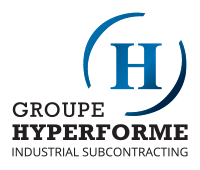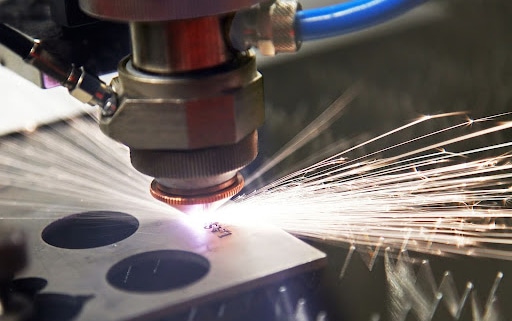Laser Metal Cutting: Industrial Outsourcing Guide
Laser metal cutting has become essential in the industrial outsourcing sector, offering unmatched precision for complex projects. Whether working with sheet metal or thick parts, this technology allows for clean and fast cutting, suitable for a wide range of materials. This high-precision process ensures complex and repeatable cuts while optimizing production. In this guide, we explain how laser cutting can reduce your production costs and increase the efficiency of your operations.
What is laser cutting?
Laser cutting is a cutting-edge technology used in the industry to cut materials, including metal sheets or plates, with exceptional precision. This process uses an adjustable laser beam, directed by high-performance laser cutters, to trace complex shapes according to design requirements.
Its ability to work with great precision on various materials, including those of different thicknesses, makes it a preferred method among manufacturing companies. This process allows for clean and precise cuts, even for complex geometries, while optimizing production times.
Do you have a laser-cutting project?
The main types of lasers used for metal cutting
Here are the main types of lasers used for metal cutting:
- CO₂ Laser: Effective for cutting thin metals such as mild steel and aluminum.
- Fiber Laser: Ideal for the fast cutting of reflective metals like aluminum and copper.
- Nd (Neodymium-YAG) Laser: Suitable for cutting thick and hard metals like alloy steel.
- Disk Laser: Offers exceptional cutting quality with high energy efficiency.
- Excimer Laser: Used for ultra-precise cutting with low heat generation.
Groupe Hyperforme: The laser cutting process in 6 steps
This process relies on using a concentrated laser beam to melt, burn, or vaporize the material, thus creating a clean and precise cut. Here are the key steps in the laser cutting process:
1. Laser beam generation
The process begins with generating a powerful laser beam. This beam is produced in the laser source (CO₂, fiber, Nd, etc.) and is then amplified and directed towards the cutting head. The beam is highly concentrated, often with a diameter of less than 0.1 mm.
2. Beam concentration
The laser beam is then focused by lenses or mirrors in the cutting head, concentrating the laser energy on a very small area. This creates a high energy density capable of quickly heating, melting, or vaporizing the material at that specific location.
3. Melting and vaporization
When the laser beam comes into contact with the material, it heats it to an extremely high temperature. The heat melts, burns, or vaporizes the material at the point of impact, creating a cut. The types of lasers and the power of the beam determine the types of materials that can be cut.
4. Ejection of melted material
During cutting, an assist gas (often nitrogen, oxygen, or compressed air) is blown through the cutting head. This gas expels debris and melted material from the cutting area while cooling the zone to avoid warping.
5. Controlled movement of the cutting head
The cutting head is generally controlled by a CNC (computer numerical control) system that guides the movement of the laser beam according to a pre-programmed pattern. This allows for precise and complex cuts, including curves and custom shapes.
6. Cooling and finishing
Once the cut is complete, the cutting area cools rapidly, often with the help of the assist gas. The resulting edges are generally clean and smooth, reducing the need for additional finishing.
Reduce your costs with Groupe Hyperforme
Industrial applications of laser metal cutting
Here are some industrial applications of laser metal cutting:
- Automotive industry: Precise cutting of metal components for chassis, body parts, and mechanical elements.
- Aerospace: Manufacturing of complex and lightweight parts with strict tolerances.
- Construction: Cutting of metal structures such as beams, steel plates, and frameworks.
- Appliance manufacturing: Production of metal parts for refrigerators, washing machines, and other appliances.
- Electronics: Creation of metal casings and components for circuit boards and electronic devices.
- Medical industry: Production of surgical instruments, prosthetics, and medical devices with high precision.
- Energy and infrastructure: Manufacturing of components for pipelines, tanks, and power production systems.
- Arts and design: Cutting of metal panels for artistic works, decorative structures, and signs.
Outsource your industrial operations
How much do industrial laser metal cutting services cost?
The cost of industrial laser cutting services varies based on several factors, such as material thickness, project complexity, and the number of parts to be cut. Generally, prices can range from a few hundred to several thousand dollars depending on the scope of work.
Engaging a specialized subcontractor with expertise in laser cutting ensures not only extreme precision but also a competitive edge for companies seeking quality solutions. These services help reduce timelines and optimize costs while ensuring impeccable results that meet high-precision requirements.
Groupe Hyperforme: Comparison with other metal cutting methods
Water jet cutting
Water jet cutting uses a high-pressure water jet, often combined with abrasives, to cut metals and other materials. The main advantage of this method is that it does not involve heat, thus avoiding thermal deformations. This makes it an ideal solution for cutting heat-sensitive materials, such as certain ceramics or thin metals. However, water jet cutting is slower than laser cutting and incurs high costs in consumables (like abrasives). It is particularly used in industries requiring precision cutting without thermal alteration.
Plasma cutting
Plasma cutting uses a high-temperature ionized gas jet, or plasma, to melt and cut metals. It is a fast method, especially for thick materials, such as mild steel or stainless steel. It is often used in industries where fast and relatively precise cuts are needed, such as metal construction or heavy part manufacturing. Although plasma cutting is less expensive than laser cutting, it offers lower precision and often rougher edges, sometimes requiring additional finishing.
Mechanical cutting (sawing, milling, punching)
Mechanical cutting methods, such as sawing, milling, and punching, rely on using physical tools to remove material. They are widely used in traditional industries for simple and low-cost cuts. However, these methods are less precise and slower than modern technologies like laser cutting. Additionally, mechanical tools wear out quickly, requiring frequent replacements, which can increase long-term costs. These methods are generally reserved for work requiring basic and robust cuts.
Oxy-fuel cutting
Oxy-fuel cutting is a cutting technique using a gas mixture, often oxygen, to heat the metal and cause combustion. This method is particularly effective for cutting very thick metals, notably carbon steel. However, it has limitations as it is not suitable for non-ferrous metals like aluminum or stainless steel. Due to its slowness and reduced precision compared to technologies like laser or plasma, oxy-fuel cutting is often used for applications in heavy construction and metal structure repairs.
CNC punching
CNC punching involves using a press to perforate or cut shapes in metal sheets. It is a fast and cost-effective method for simple and repetitive cuts, particularly suited for mass production. While effective for basic geometric shapes, CNC punching is limited when it comes to complex patterns or fine details, where laser cutting excels.
Groupe Hyperforme: Laser cutting services
Groupe Hyperforme stands out in the industrial outsourcing sector by offering a complete range of custom services to meet your specific needs. Our expertise encompasses the manufacturing of metal parts, assembly, surface treatment, and much more, using cutting-edge technologies such as laser cutting, bending, and high-precision machining.With a modern infrastructure and proven expertise, our team enables its industrial partners to optimize their production while ensuring superior quality and adherence to deadlines. Our flexibility and commitment to innovation make us the ideal partner for companies looking to outsource critical parts of their production.
To stay informed about the latest news, follow us on our social media and join our online community:






